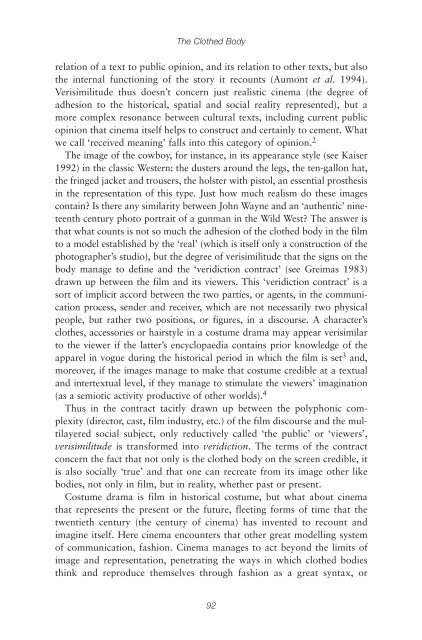Create successful ePaper yourself
Turn your PDF publications into a flip-book with our unique Google optimized e-Paper software.
<strong>The</strong> <strong>Clothed</strong> <strong>Body</strong><br />
relation of a text to public opinion, and its relation to other texts, but also<br />
the internal functioning of the story it recounts (Aumont et al. 1994).<br />
Verisimilitude thus doesn’t concern just realistic cinema (the degree of<br />
adhesion to the historical, spatial and social reality represented), but a<br />
more complex resonance between cultural texts, including current public<br />
opinion that cinema itself helps to construct and certainly to cement. What<br />
we call ‘received meaning’ falls into this category of opinion. 2<br />
<strong>The</strong> image of the cowboy, for instance, in its appearance style (see Kaiser<br />
1992) in the classic Western: the dusters around the legs, the ten-gallon hat,<br />
the fringed jacket and trousers, the holster with pistol, an essential prosthesis<br />
in the representation of this type. Just how much realism do these images<br />
contain? Is there any similarity between John Wayne and an ‘authentic’ nineteenth<br />
century photo portrait of a gunman in the Wild West? <strong>The</strong> answer is<br />
that what counts is not so much the adhesion of the clothed body in the film<br />
to a model established by the ‘real’ (which is itself only a construction of the<br />
photographer’s studio), but the degree of verisimilitude that the signs on the<br />
body manage to define and the ‘veridiction contract’ (see Greimas 1983)<br />
drawn up between the film and its viewers. This ‘veridiction contract’ is a<br />
sort of implicit accord between the two parties, or agents, in the communication<br />
process, sender and receiver, which are not necessarily two physical<br />
people, but rather two positions, or figures, in a discourse. A character’s<br />
clothes, accessories or hairstyle in a costume drama may appear verisimilar<br />
to the viewer if the latter’s encyclopaedia contains prior knowledge of the<br />
apparel in vogue during the historical period in which the film is set 3 and,<br />
moreover, if the images manage to make that costume credible at a textual<br />
and intertextual level, if they manage to stimulate the viewers’ imagination<br />
(as a semiotic activity productive of other worlds). 4<br />
Thus in the contract tacitly drawn up between the polyphonic complexity<br />
(director, cast, film industry, etc.) of the film discourse and the multilayered<br />
social subject, only reductively called ‘the public’ or ‘viewers’,<br />
verisimilitude is transformed into veridiction. <strong>The</strong> terms of the contract<br />
concern the fact that not only is the clothed body on the screen credible, it<br />
is also socially ‘true’ and that one can recreate from its image other like<br />
bodies, not only in film, but in reality, whether past or present.<br />
Costume drama is film in historical costume, but what about cinema<br />
that represents the present or the future, fleeting forms of time that the<br />
twentieth century (the century of cinema) has invented to recount and<br />
imagine itself. Here cinema encounters that other great modelling system<br />
of communication, fashion. Cinema manages to act beyond the limits of<br />
image and representation, penetrating the ways in which clothed bodies<br />
think and reproduce themselves through fashion as a great syntax, or<br />
92

















